Just in case you haven’t seen this bit of awesome yet: Noctilucent clouds and aurora showed up together in skies over Scotland on the night of August 4/5, 2013. Maciej Winiarczyk from the Caithness Astronomy Group was on hand to capture it.
Enjoy!
Just in case you haven’t seen this bit of awesome yet: Noctilucent clouds and aurora showed up together in skies over Scotland on the night of August 4/5, 2013. Maciej Winiarczyk from the Caithness Astronomy Group was on hand to capture it.
Enjoy!
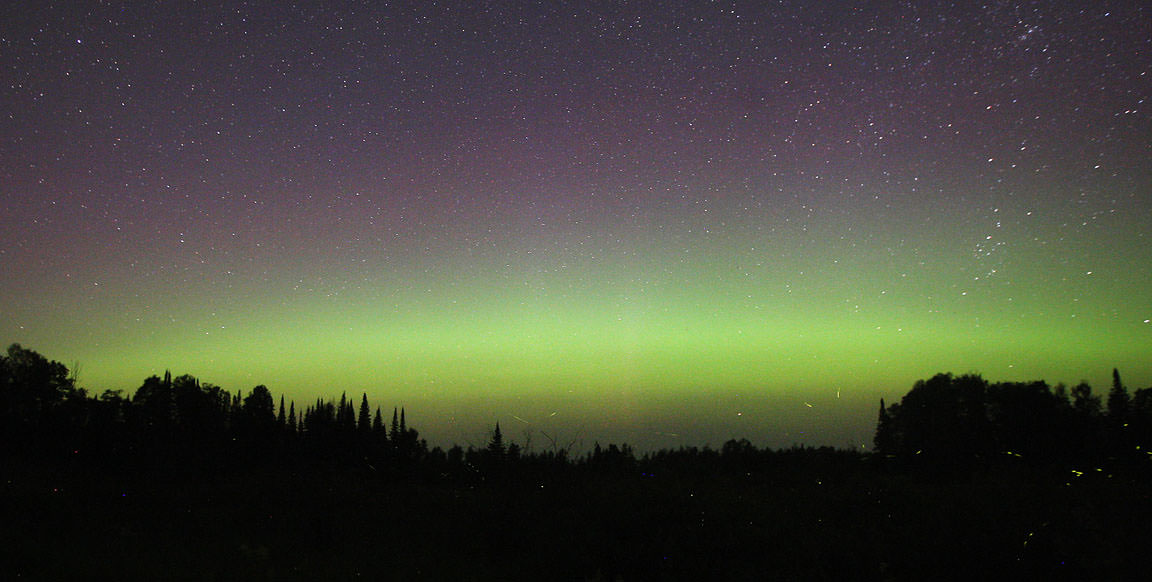
A burst of energetic particles from the Sun called a coronal mass ejection peppered Earth’s magnetic field yesterday afternoon sparking a modest but beautiful all-night display of the aurora borealis. Another light show may be in the offing tonight for skywatchers living in the northern U.S., Canada and northern Europe.
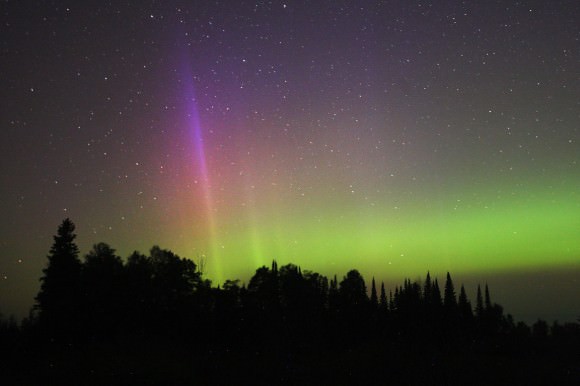
Pale green fingers of light splayed across the northern sky at twilight’s end came as a surprise. NOAA space weather forecasters had predicted little activity. These soon faded but a thick, fuzzy arc persisted throughout the night. It arched from horizon to horizon across the northern sky like a pallid, monochromatic rainbow. Such arcs are common. Often the aurora never gets past this stage and simmers quietly or even fades away during the night.
Not this one. Around local midnight (1 a.m. CDT) here in Duluth, Minn. small bright spots and a series of tall, faint rays punctuated the arc and over the span of a half-hour completely reshaped it into loopy rayed arcs resembling a crown.
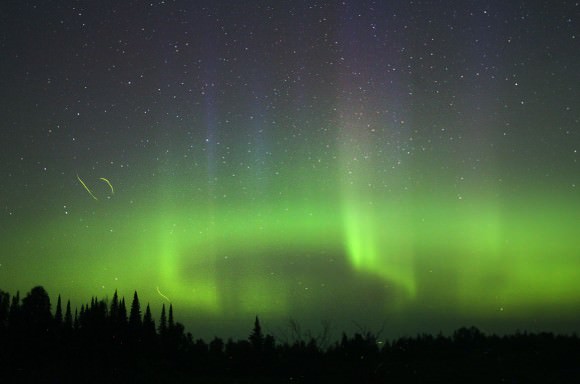
To the eye, the brightest parts of the aurora appeared green, but the taffy-stretched rays were colorless. The camera’s sensitivity coupled with a 30-second time exposure revealed striking pinks and hints of blue. Both pink and green colors are caused by the emission of light from oxygen atoms.
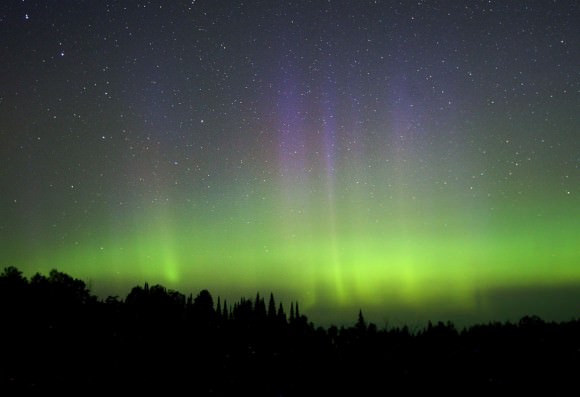
Bombarded by high-speed solar wind electrons and protons, they get jazzed into higher energy states. When the atoms return to rest, each spits out a photon of green or red light. All those tiny flashes add up. Multiplied by the billions of atoms that exist even in the rarefied air at the aurora’s typical 60-150 mile (100-250 km) altitude and you get heavenly eye candy.
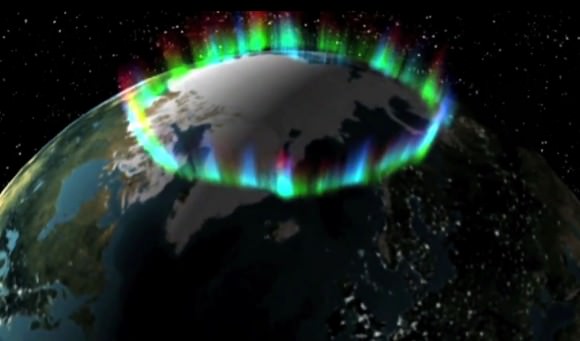
I started watching the northern lights at 11 from home then took a drive to darker skies. Even at dawn’s 3 a.m. start, the green arc held its own shot through with rays that occasionally towered halfway up the northern sky. While this display wasn’t a grand spectacle like some auroras, it possessed a certain majesty the same way a long, slow movement concludes a great symphony.
Chances for more of the same continues through tonight and possibly into tomorrow, so keep a watch on the northern sky before you hit the hay tonight. If you see something green and glowing it you might be in for a treat.
In another installment, I’ll share tips on how best to see the northern lights and share several excellent tools you can use for predicting when they might occur.
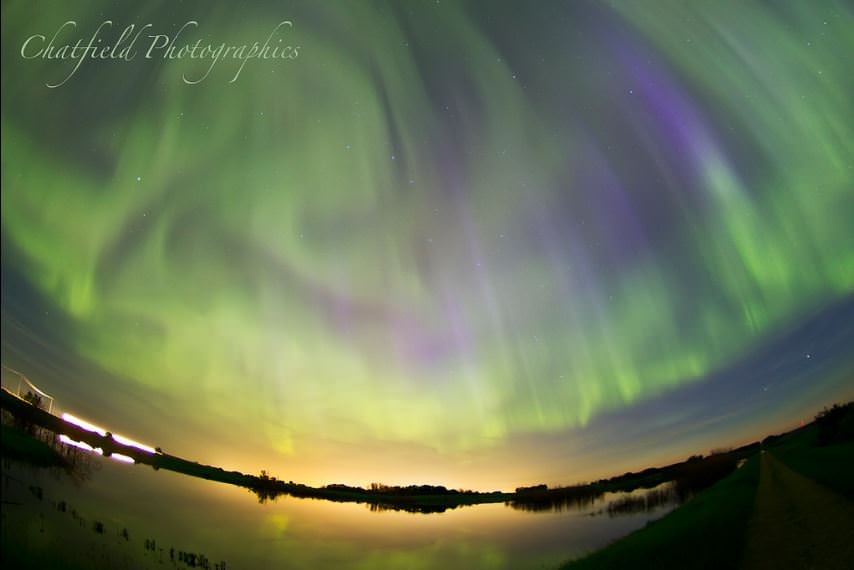
I was personally so pumped to have seen the Aurora Borealis over the weekend in Central Minnesota! It was a beautiful display of a green and white glow with high, towering, bright spires. Unfortunately, I was in the car at the time, and I definitely need to upgrade my camera to be able to take images of the aurora. But lucky for us, astrophotographers from both hemispheres captured gorgeous shots of the Aurora Borealis and Aurora Australis.
According to SpaceWeather.com, the Earth passed through a region of south-pointing magnetism in the solar wind on June 28, “and the encounter set off one of the finest geomagnetic storms of the current solar cycle.”
This shot from Colin Chatfield shows the awesome auroral scenes over Saskatchewan.
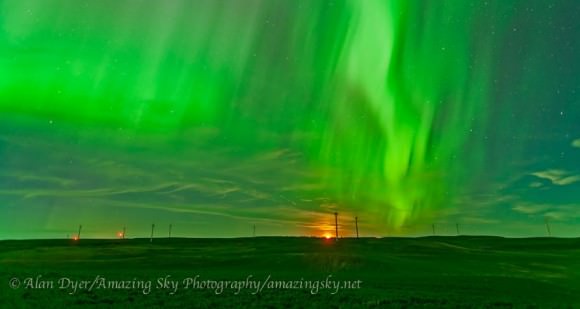
James Stone from Opossum Bay, Tasmania captured this video of the Aurora Australis:
To see some images from the southern hemisphere, Ian Musgrave has put together a great collection at his Astroblog site.

Yep, you really want to click on this image to see the larger version on Flickr. Wow — what a view!!
This is a 360° horizon pan, seen by Alan Dyer — who has an aptly named website, The Amazing Sky. This is a view seen from southern Alberta on June 5, 2013, and there is a lot going on in this image. Alan described it on Flickr: “There’s the Milky Way arching across the sky on the right, a low aurora to the north, perpetual twilight glow to the north (left of center) and bands of green airglow across the sky. Left of the house and also left of the main area of Milky Way are horizon glows from urban light pollution. A satellite, the ESA Einstein ATV going to the ISS, is at left of frame.”
I get extremely excited if I can see *one* of those things in a night, and here Alan has captured all at once — superb!
But wait, there’s more!
On June 10, Alan was able to take a timelapse of the Northern Lights and some noctilucent clouds, and it is gorgeous. See below:
Alan said on his website, “This was certainly one of the best NLC displays I’d seen and my best shot at capturing them.”
Find out more about this video here, and Alan shared his technical data on the image:
The Panorama was stitched in PTGui software from 8 images taken at 45° spacing with the 8mm lens at f/3.5 on the Canon 5D MkII at ISO 3200. Each is an untracked 1 minute exposure.
© 2013 Alan Dyer
Want to get your astrophoto featured on Universe Today? Join our Flickr group or send us your images by email (this means you’re giving us permission to post them). Please explain what’s in the picture, when you took it, the equipment you used, etc.
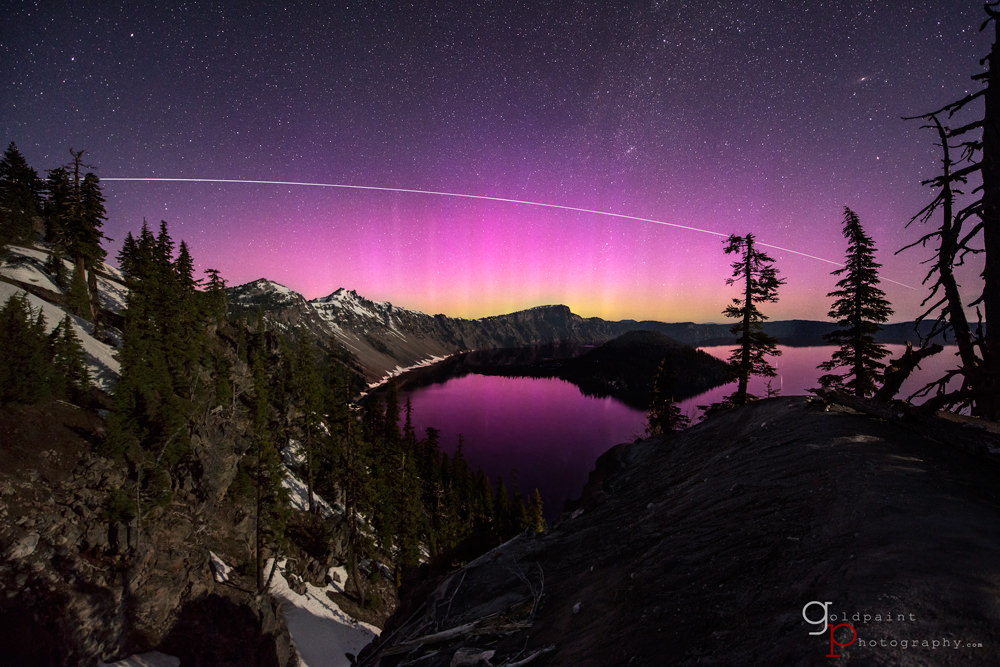
An unexpected arrival of a surprisingly strong (6 KP) geomagnetic storm from the Sun provided an amazing weekend for astrophotographers. Stargazers from both hemispheres were treated with seeing the aurora. We already posted the images from Mike Hollingshead seeing the aurora and red sprite lightning in Iowa, but here are some more great views, including this gorgeous shot of the aurora over Crater Lake in Oregon, from astrophotographer Brad Goldpaint, with the added intrigue of the International Space Station flying over at 2:35 am, local time. He’s also provided an amazing video, too, below.
“I drove to Crater Lake National Park last night to photograph the Milky Way rising above the rim,” Goldpaint said via email to Universe Today. “I’ve waited months for the roads to open and spring storms to pass, so I could spend a solitude night with the stars. Near 11pm, I was staring upward towards a clear night sky when suddenly, without much warning, an unmistakable faint glow of the aurora borealis began erupting in front of me. I quickly packed up my gear, hiked down to my truck, and sped to a north facing location. With adrenaline pumping, I raced to the edge of the caldera, set up a time-lapse sequence, and watched northern lights dance until sunrise. The moon rose around 2am and blanketed the surrounding landscape with a faint glow, adding depth and texture to the shot.”
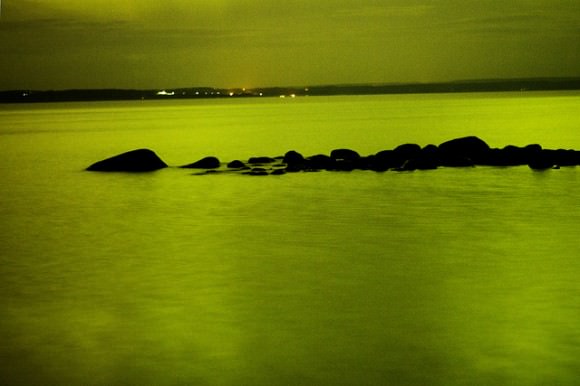
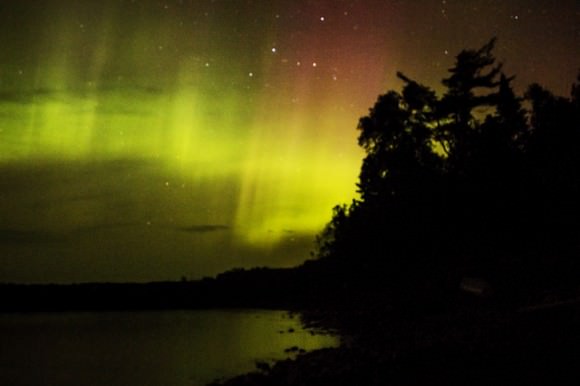
This video from Loic Le Guilly shows the aurora australis (southern lights) and the glow of the Milky Way in the skies over Tasmania he saw at Signal Station, near Hobart, Tasmania:
Aurora Australis, Signal Station, Hobart from Loic Le Guilly on Vimeo.
This great aurora video comes from Yuichi Takasaka, taken near Lumby, British Columbia:
Mid-Latitude Auroras in May 31, 2013 from Yuichi Takasaka on Vimeo.
Want to get your astrophoto featured on Universe Today? Join our Flickr group or send us your images by email (this means you’re giving us permission to post them). Please explain what’s in the picture, when you took it, the equipment you used, etc.
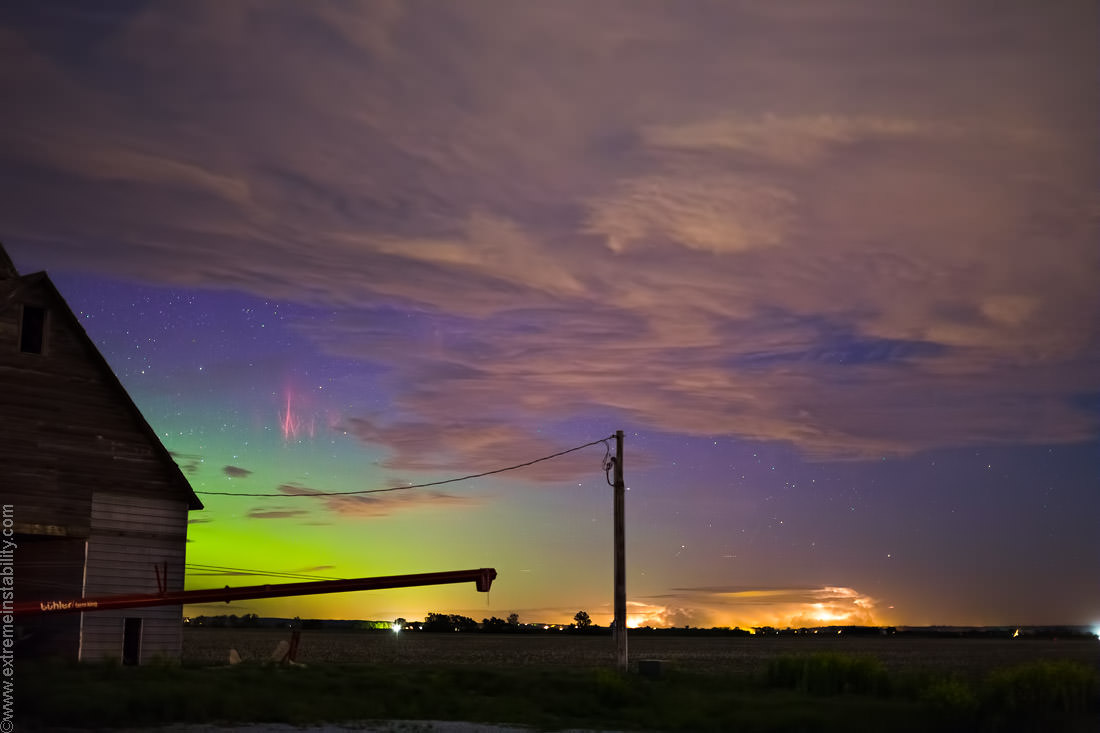
“Holy crap, this is the rarest scene I’ve ever captured and likely ever will,” said photographer Mike Hollingshead. “I was standing there just watching when bam, big red sprites ‘squirting’ up into the air in the aurora.”
Mike said was hoping to see the aurora the night of May 31, 2013, and felt lucky when he saw a faint yellow glow begin to rise in the skies. At the same time, a thunderstorm could be seen off on the horizon and almost before he could even ponder the possibility of seeing something unusual, sprites started appearing.
This is an extremely rare event to be captured on film; in fact an image appearing just a few days ago on Astronomy Picture of the Day (APOD) on May 22 showed red sprite lighting with an aurora, and the APOD team said the image was a “candidate for the first color image ever recorded of a sprite and aurora together.”
“Sprites were first imaged in 1989 accidentally and first color photograph in 1994,” wrote Mike on his Extreme Instability website. “Recent. But with auroras, evidently it is possible the very first time was a couple freaking weeks before this one of mine. It’s that crazy rare.”
Sprites are huge electrical discharges that occur high above thunderstorm clouds. They are rare, but at least one has been captured on film from the International Space Station. They are triggered by the discharges of positive lightning between an underlying thundercloud and the ground. They often occur in clusters within the altitude range 50–90 km above the Earth’s surface.
You can read all the details on Mike’s website. And Mike also got his wish for seeing great auroras that night:
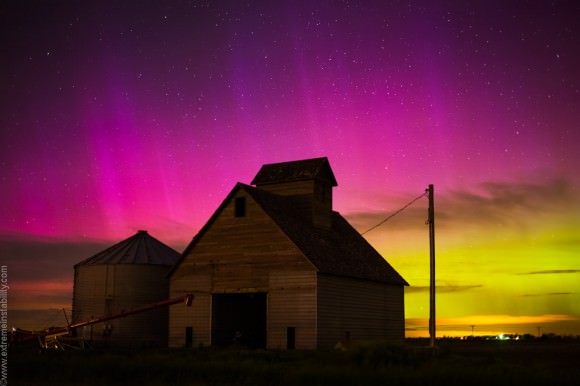
Stunning! Thanks to Mike Hollingshead for sharing his amazing photos, and congratulations on capturing such a rare event!
Want to get your astrophoto featured on Universe Today? Join our Flickr group or send us your images by email (this means you’re giving us permission to post them). Please explain what’s in the picture, when you took it, the equipment you used, etc.
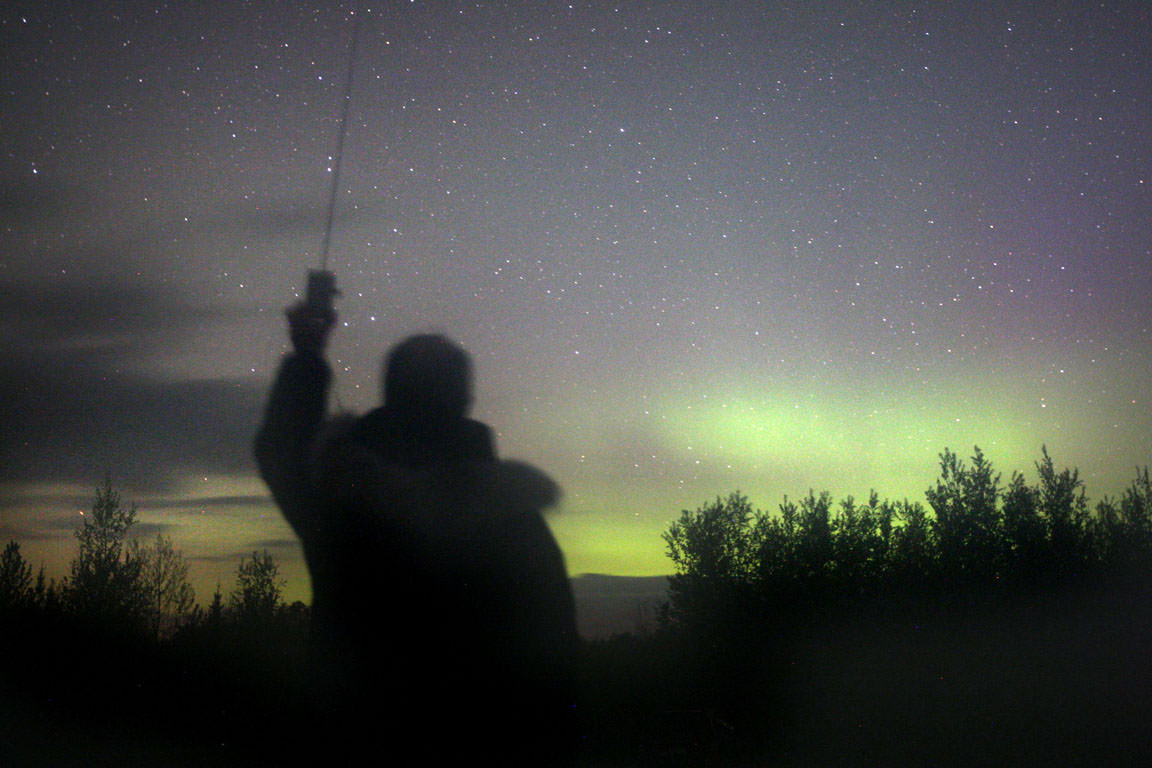
Do the aurorae makes sounds? That’s been a subject of discussion — and contention — among people who watch the sky. While most of us will never hear the aurora borealis directly, there’s help out there in the form of a little handheld radio. It’s called a VLF receiver and guarantees you an earful the next time the aurora erupts.
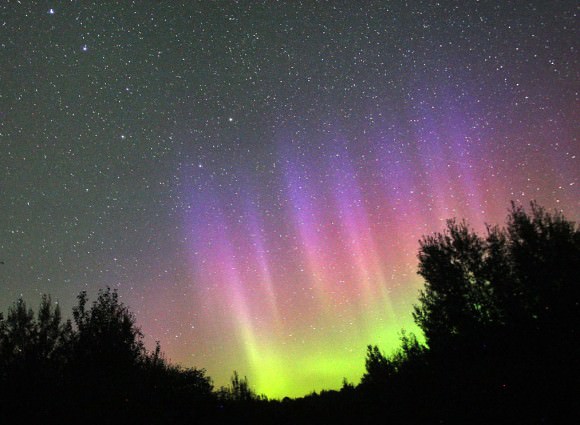
Despite seeing hundreds of northern light displays ranging from mild to wild, I’ve yet to actually hear what some describe as crackles and hissing noises. There is some evidence that electrophonic transduction can convert otherwise very low frequency (VLF) radio waves given off by the aurora into sound waves through nearby conductors. Wire-framed eyeglasses, grass and even hair can act as transducers to convert radio energy into low-frequency electric currents that can vibrate an object into producing sound. Similar ‘fizzing’ sounds have been recorded by meteor watchers that may happen the same way.
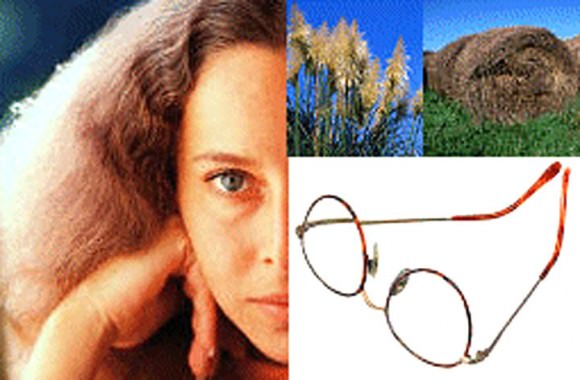
Imagination may be another reason some folks people hear auroras. Things that move often make sounds. A spectacular display of moving lights overhead can trick your brain into serving up an appropriate soundtrack. Given that the aurora is never closer to the ground than 50 miles, the air is far too thin at this altitude to transmit any weak sound waves that might be produced down to your ears.
If you’re like me and hard of auroral hearing, a small VLF (very low frequency) radio receiver will do the job nicely. This handheld device converts very low frequency radio waves produced from the interaction of the solar electrons and protons with the Earth’s magnetic field into sounds you can listen to with a pair of headphones.
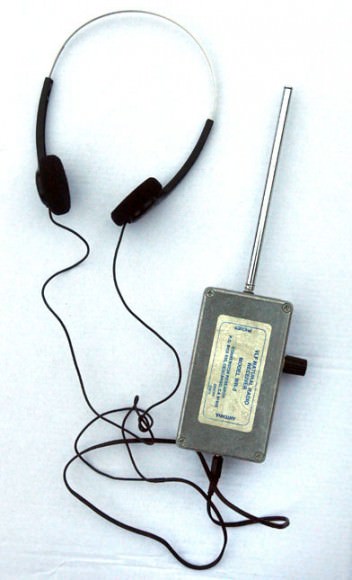
We’re used to waves of light which are very, very short, measuring in the millionths of an inch long. The pigments in our retinas convert these waves into visible images of the world around us. Radio waves given off by auroras and other forms of natural ‘Earth energy’ like lightning range from 19 to 1,800 miles long or longer. To bring them within range of human hearing we need a radio receiver. I fire up a little unit called a WR-3 I purchased back in the mid-1990s. The components are housed in a small metal box with a whip antenna and powered by a 9-volt battery. The on-off switch also controls the volume. Plug in a set of headphones and you’re ready to listen. That’s all there is to it.
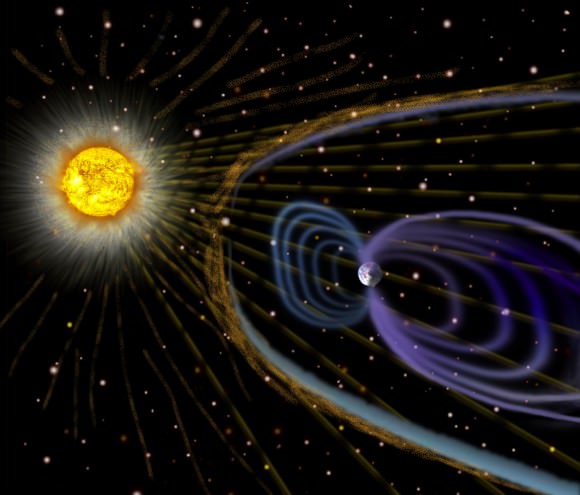
The receiver picks up lots of things besides aurora including a big ‘unnatural’ hum from alternating or AC current in power lines and home appliances. Turn one on in your house and you’ll immediately hear a loud, continuous buzz in the headphones. You’ll need to be at least a quarter mile from any of those sources in order to hear the more subtle music of the planet.
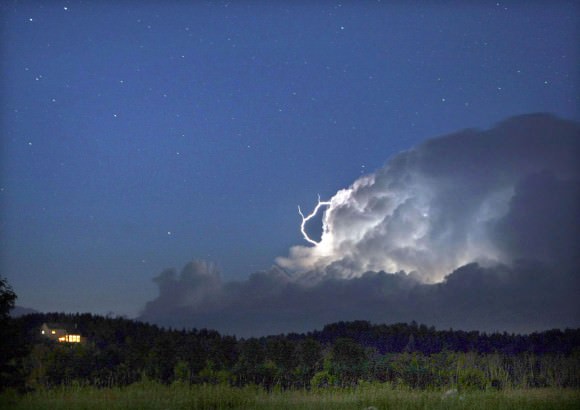
I drive out to a open ‘radio quiet’ rural area, turn on the switch and raise the antenna to the sky. Don’t stand under any trees either. They’re great absorbers of the low frequency radio energy you’re trying to detect. What will you hear? Read on and click the links to hear the sound files.
* Sferics. The first thing will be the pops, crackles and sizzles of distant lightning called sferics which are similar to the crackles on an AM car radio during a thunderstorm.
* Tweeks. Lightning gives off lots of energy in the long end of the radio spectrum. When that energy gets ducted through the upper layers of Earth’s atmosphere called the ionosphere over distances of several thousand miles, it emits another type of sound called ‘tweeks‘. These remind me of Star Wars lasers or dripping water. Flurries of tweeks have an almost musical quality like someone plucking the strings of a piano.
* Whistlers and Whistler Clusters. When those same lightning radio waves enter Earth’s magnetosphere and interact with the particles there, they can cycle back and forth between the north and south geomagnetic poles traveling tens of thousands of miles to create whistlers. Talk about an eerie, futuristic sound. After their long journey, the higher frequency waves arrive before those of lower frequency causing the sound to spread out in a series of long, descending tones. The sound may also take you back to those old World War II movies when bombs whistled through the air after dropping from the hatch of a B-17. Tweeks are very brief; whistlers last anywhere from 1/2 to 4 seconds or longer.
* Dawn Chorus. Sometimes you’ll hear dozens of whistlers, one after the other. When conditions are right, a VLF receiver can pick up disturbances in Earth’s magnetic bubble spawned by auroras called ‘chorus‘ or ‘dawn chorus’. Talk about strange. Who would have guessed that solar electrons spiraling along Earth’s magnetic field lines would intone the ardor of frogs or a chorus of birds at dawn? And yet, there you have it.
* More Dawn Chorus: On a good night, and especially when the northern lights are out, it’s a magnetospheric symphony. Thunderstorms thousands of miles away provide a bounty of crackles and tweeks with occasional whistlers. Listen closely and you might even hear the froggy voice of the aurora rising and falling with a rhythm reminiscent of breathing.
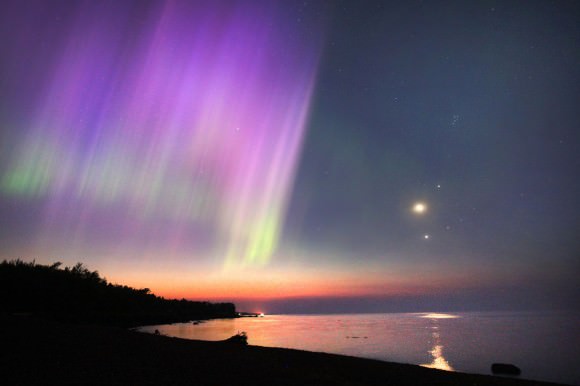
If you’re interested in listening to VLF and in particular the aurora, basic receivers are available through the two online sites below. I’ve only used the WR-3 and can’t speak for the others, but they all run between $110-135. One word of warning if you purchase – don’t use one when there’s a lightning storm nearby. Holding a metal aerial under a thundercloud is not recommended!
* WR-3 VLF receiver from Stephen McGreevy
* North Country Radio ELF Earth Receiver
More on natural radio can be found HERE. Things to keep in mind when considering a purchase are whether you have access to an open area 1/2 mile from a power line and away from homes. You’ll also need patience. Many nights you’ll only hear lightning crackles from distant storms thousands of miles away peppered by the occasional ping of a tweet. Whistlers may not appear for weeks at a time and then one night, you’ll hear them by the hundreds. But if you regularly watch the sky, it’s so easy to take the radio along and ‘give a listen’ for some of the most curious sounds you’ll ever hear. How astonishing it is to sense our planet’s magnetosphere through sound. Consider it one more way to be in touch with the home planet.
For more on natural radio including additional sound files I invite you to check out Stephen P. McGreevy’s site.
This beautiful new timelapse video might have folks heading in droves for northern Michigan. Shawn Malone of Lake Superior Photo put together this incredible video — her first attempt at a timelapse compilation, believe it or not — using over 10,000 photo frames showing 33 different scenes of various night sky events from northern Michigan over the past year. “It took a year to shoot and a bit of tenacity and persistence to get this into a form of coherent electrified cosmic goodness,” Malone wrote on Vimeo. And did she ever capture cosmic goodness: auroras, the Milky Way rising and setting, meteor showers, a comet, and even aurora and lightning together in one scene. Just gorgeous….
This year, there have been some epic auroral displays, and astrophotographer Ole C. Salomonsen has just released this new video which includes real-time recordings of these “polar spirits.”
“My main focus is on getting the auroras [to] show as close as possible to real-time speed given the time available in a short video,” Salomonsen wrote on Vimeo. “In the film I have tried to show the slower majestic dancing lights, as well as the more faster, dramatic and abstract shows, and finally the auroras in combination with city lights and urban elements.”
Simply stunning, and if you watch closely on the opening sequence you can actually see some whales breaching out in the fjord!
POLAR SPIRITS from Ole C. Salomonsen on Vimeo.
This is awesome. Astrophotographer Göran Strand took his 30 gigabytes of image data of the incredible aurora he shot on March 17 (which we shared here) and re-tooled everything to fit into an interactive virtual reality-type video where the viewer can move and pan around in any direction. You can watch below, or click here to see the full screen version and be transported to a small town in northern Sweden called Östersund.
Strand said he was almost obsessed with creating this virtual reality version to try and share the experience.
“Hopefully this means that I finally can close the case on the auroras from March 17,” he told Universe Today via email. “As you might understand, these amazing auroras had a big impact on me and I really want to show how wonderful it was.”
Here’s the virtual reality version. Use the arrow keys on your computer to move the view around in any direction:
Here’s the orignal video that Strand created: